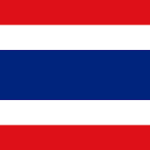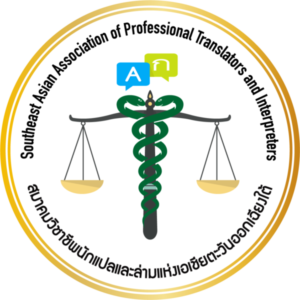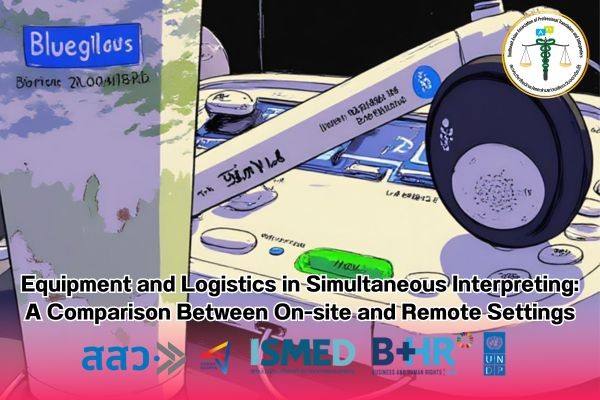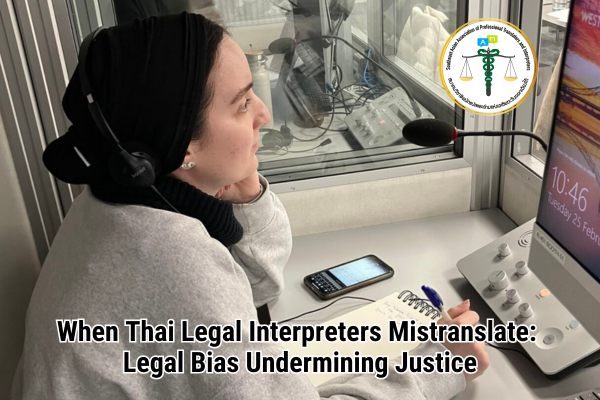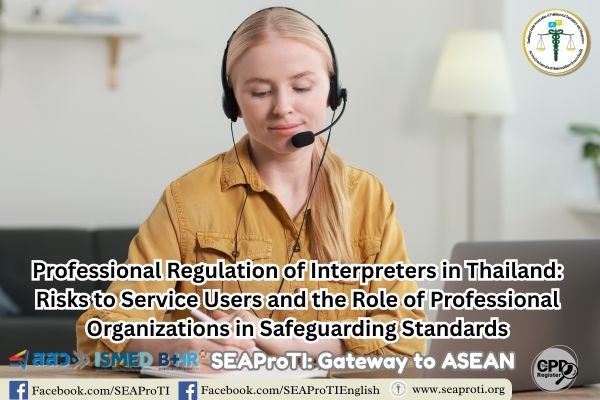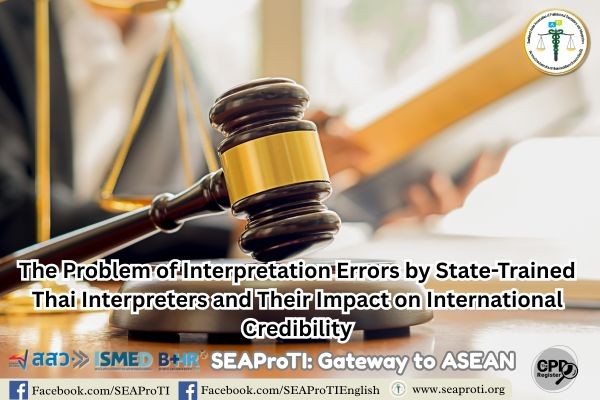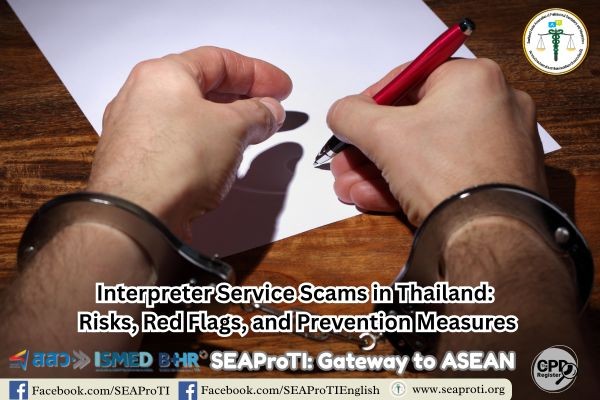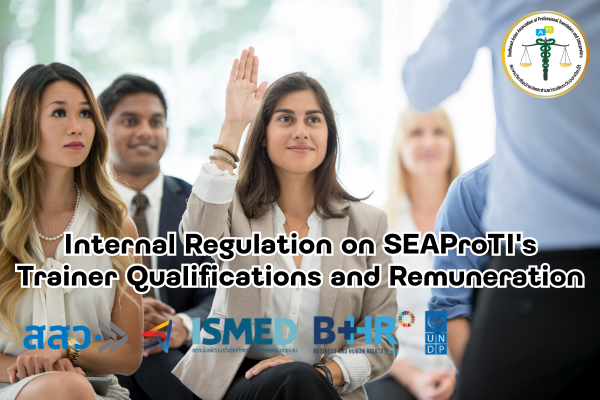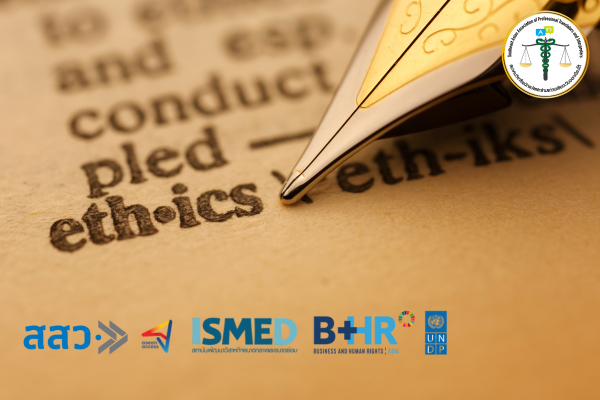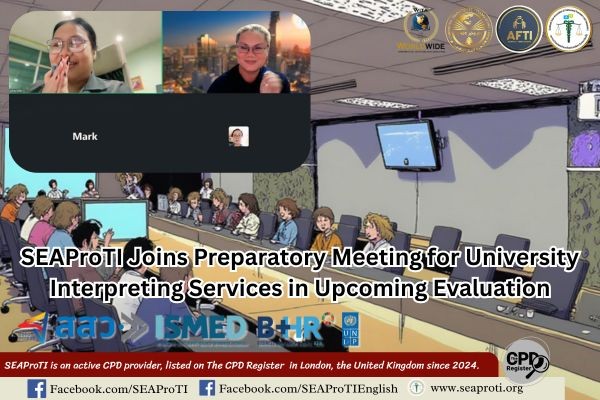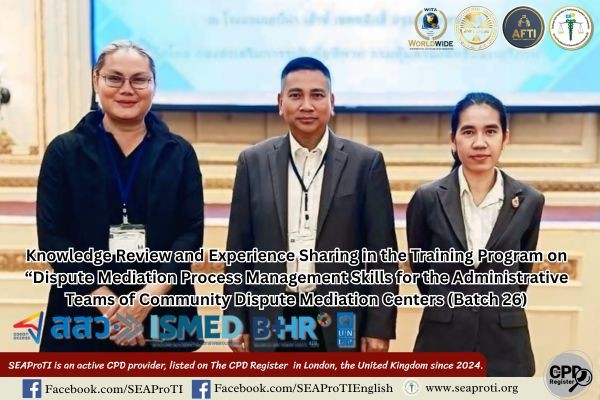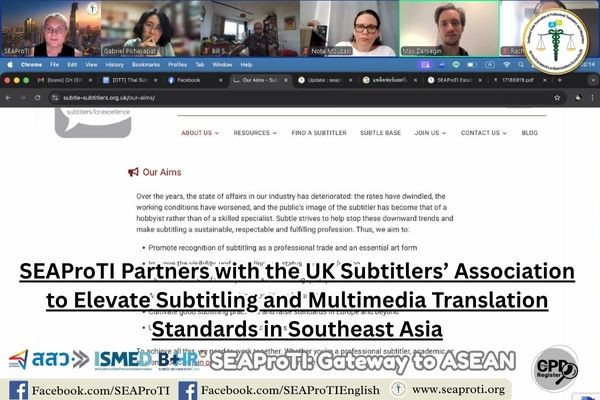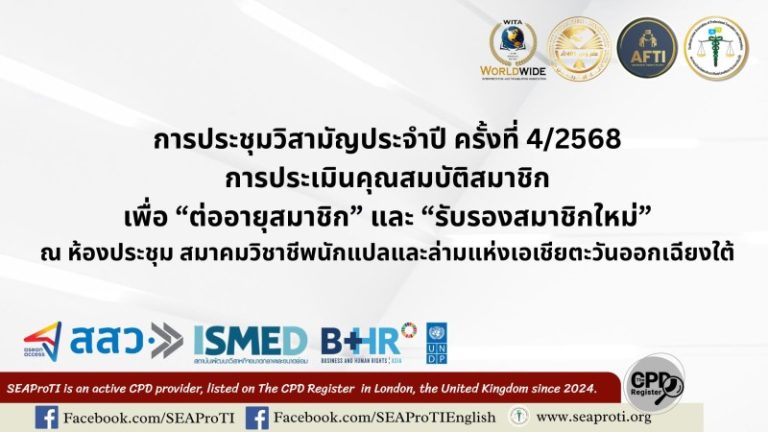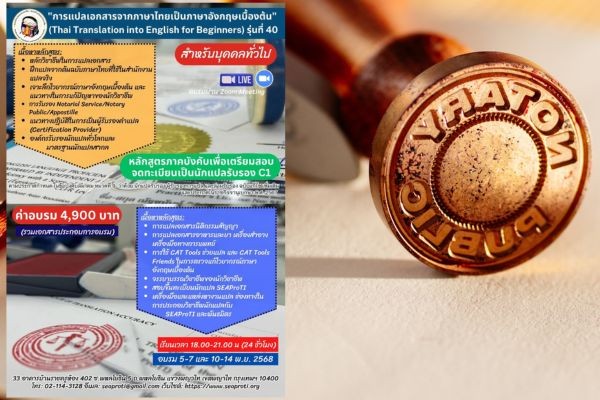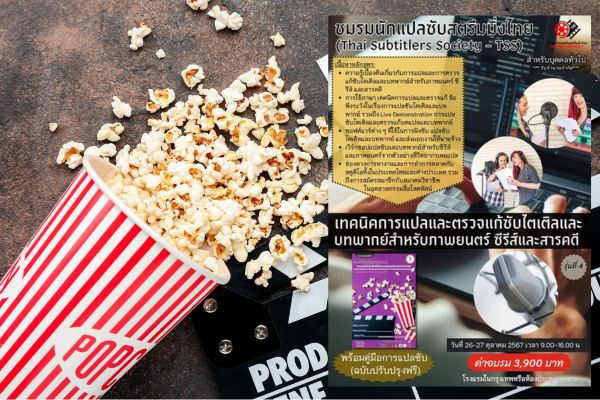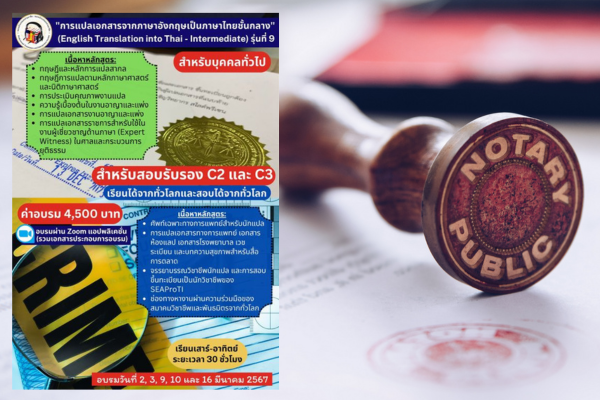Equipment and Logistics in Simultaneous Interpreting: A Comparison Between On-site and Remote Settings
18 August 2025, Bangkok – Simultaneous interpreting (SI) is an essential communication tool in international conferences, whether in diplomacy, business, or intergovernmental organizations. The choice between on-site simultaneous interpreting (OSI) and remote simultaneous interpreting (RSI) depends not only on interpreter availability but also on the equipment and logistics required, which significantly affect overall costs and service quality (AIIC, 2021; ISO, 2016, 2017, 2022).
On-site Simultaneous Interpreting (OSI)
Required Equipment
On-site interpreting relies on standardized equipment, including:
- Soundproof interpreter booths
- Interpreter consoles
- Microphones and headsets for delegates
- A technician for sound system support
Budget Implications
The costs of OSI extend beyond interpreter fees and typically include:
- Rental and transportation of booths and consoles
- Setup and dismantling fees
- Technician service fees
In many cases, logistical and equipment-related costs may exceed interpreter fees, substantially increasing the overall budget (Donovan, 2017).
Remote Simultaneous Interpreting (RSI)
Required Equipment
RSI is based on digital platforms with interpreter functions such as Zoom Interpreter Mode, Kudo, or Interprefy. Interpreters require:
- A computer with high-quality headsets
- Stable, high-speed internet
- A quiet, professional working environment
Budget Implications
RSI reduces the need for large-scale rental and onsite setup. While it introduces new costs, such as:
- Platform licensing fees
- Technical support for online operation
- Overall budgets are generally lower than for OSI, even when interpreter daily rates remain similar (Moser-Mercer, 2018).
Comparison of OSI and RSI
| Criteria | On-site (OSI) | Remote (RSI) |
|---|---|---|
| Equipment | Booths, consoles, microphones, headsets, technician | Computer, headset, online platform |
| Additional Costs | Equipment rental, technicians, travel, installation | Platform fees, internet |
| Reliability | Stable audio/video quality if ISO standards are met | Risk of connectivity and software issues |
| Flexibility | Limited to physical venue | Flexible, accessible from multiple locations |
Conclusion
Both OSI and RSI offer unique advantages and limitations. OSI ensures high-quality sound and formal reliability but comes with significant logistical and equipment-related expenses. In contrast, RSI reduces costs and enhances flexibility, though it presents risks related to connectivity and digital infrastructure. Choosing between the two modes requires considering not only interpreter fees but also the overall budget, event context, and the technical standards that can be ensured.
References
- AIIC. (2021). Remote simultaneous interpreting: Best practices. International Association of Conference Interpreters. Retrieved from https://aiic.org
- Donovan, C. (2017). The impact of technology on conference interpreting: RSI and the future of the profession. Interpreting and Translation Studies Journal, 12(2), 45–63.
- ISO. (2016). Simultaneous interpreting — Built-in booths — Requirements (ISO 2603:2016). International Organization for Standardization.
- ISO. (2017). Simultaneous interpreting — Quality and transmission of sound and image input — Requirements (ISO 20108:2017). International Organization for Standardization.
- ISO. (2022). Remote simultaneous interpreting — Requirements and recommendations (ISO 24019:2022). International Organization for Standardization.
- Moser-Mercer, B. (2018). The remote interpreting experience: An integral view. The Interpreters’ Newsletter, 23, 73–92.
About Certified Translators, Translation Certification Providers, and Certified Interpreters of SEAProTI
The Southeast Asian Association of Professional Translators and Interpreters (SEAProTI) has announced the qualifications and requirements for individuals registered as Certified Translators, Translation Certification Providers, and Certified Interpreters of the Association, as stated in Chapter 9 and Chapter 10 of the Royal Gazette of the Secretariat of the Cabinet, Office of the Prime Minister of the Kingdom of Thailand, dated July 25, 2024, Volume 141, Part 66 Ngor, p. 100. Full details can be accessed at: The Royal Thai Government Gazette
SEAProTI is the first professional association in Thailand and Southeast Asia to establish a certification system for Certified Translators, Translation Certification Providers, and Certified Interpreters.
Head Office: Baan Ratchakru Building, Room 402, No. 33, Soi Phahonyothin 5, Phahonyothin Road, Phayathai District, Bangkok 10400
Email: hello@seaproti.com Telephone: (+66) 2-114-3128 (Business hours: Monday–Friday, 9:00 a.m.–5:00 p.m.)
อุปกรณ์และโลจิสติกส์ในการล่ามพูดพร้อม: การเปรียบเทียบการประชุมในสถานที่และทางไกล
18 สิงหาคม 2567, กรุงเทพมหานคร – การล่ามพูดพร้อม (Simultaneous Interpreting: SI) เป็นเครื่องมือสื่อสารสำคัญในการประชุมนานาชาติ ทั้งในระดับทางการทูต ธุรกิจ และองค์กรระหว่างประเทศ การเลือกวิธีการจัดล่าม—ไม่ว่าจะเป็นการประชุมในสถานที่ (on-site) หรือการประชุมทางไกล (remote)—ไม่เพียงแต่ขึ้นอยู่กับความพร้อมของบุคลากรเท่านั้น แต่ยังมีความแตกต่างด้านอุปกรณ์และโลจิสติกส์ที่ส่งผลต่อค่าใช้จ่ายและคุณภาพการบริการ (AIIC, 2021; ISO, 2016, 2017, 2022)
การล่ามพูดพร้อมในสถานที่ (On-site Simultaneous Interpreting: OSI)
อุปกรณ์ที่จำเป็น
การล่ามในสถานที่ต้องอาศัยอุปกรณ์มาตรฐาน ได้แก่
- ห้องบูธกันเสียง (soundproof booths)
- คอนโซลล่าม (interpreter consoles)
- ไมโครโฟนและหูฟังสำหรับผู้ร่วมประชุม
- ช่างเทคนิคคอยดูแลระบบเสียง
- ค่าใช้จ่ายของ OSI ไม่ได้จำกัดเฉพาะค่าตัวล่าม แต่ยังรวมถึง:
- ค่าขนส่งและติดตั้งอุปกรณ์
- ค่าเช่าอุปกรณ์ เช่น บูธ คอนโซล และชุดหูฟัง
- ค่าบริการช่างเทคนิคประจำงาน
ในหลายกรณี ค่าใช้จ่ายด้านอุปกรณ์และการจัดการอาจสูงกว่าค่าตัวล่าม ทำให้งบประมาณรวมเพิ่มขึ้นอย่างมีนัยสำคัญ (Donovan, 2017)
การล่ามพูดพร้อมทางไกล (Remote Simultaneous Interpreting: RSI)
RSI อาศัยแพลตฟอร์มดิจิทัลที่รองรับการล่าม เช่น Zoom Interpreter Mode, Kudo, หรือ Interprefy โดยล่ามต้องมี:
- คอมพิวเตอร์และหูฟังคุณภาพสูง
- อินเทอร์เน็ตความเร็วสูงและเสถียร
- สภาพแวดล้อมที่เงียบและเหมาะสม
- ผลกระทบด้านงบประมาณ
- ค่าแพลตฟอร์มและสิทธิการใช้งาน
- การสนับสนุนทางเทคนิคออนไลน์
อย่างไรก็ตาม เมื่อเปรียบเทียบแล้ว งบประมาณรวมของ RSI มักต่ำกว่า OSI แม้ว่าค่าตัวล่ามจะใกล้เคียงกัน (Moser-Mercer, 2018)
การเปรียบเทียบ OSI และ RSI
| เกณฑ์ | On-site (OSI) | Remote (RSI) |
|---|---|---|
| อุปกรณ์ | บูธ, คอนโซล, ไมค์, หูฟัง, ช่างเทคนิค | คอมพิวเตอร์, หูฟัง, แพลตฟอร์มออนไลน์ |
| ค่าใช้จ่ายเพิ่มเติม | ค่าเช่าอุปกรณ์, ค่าช่าง, ค่าเดินทางและติดตั้ง | ค่าแพลตฟอร์ม, ค่าอินเทอร์เน็ต |
| ความเสถียร | คุณภาพเสียงและภาพสูง (หากติดตั้งได้มาตรฐาน ISO) | เสี่ยงต่อปัญหาอินเทอร์เน็ตหรือซอฟต์แวร์ |
| ความยืดหยุ่น | จำกัดเฉพาะสถานที่จัดประชุม | ยืดหยุ่น สามารถทำได้จากหลายประเทศ |
สรุป
ทั้ง OSI และ RSI มีข้อดีและข้อจำกัดเฉพาะตัว OSI เหมาะกับงานที่ต้องการคุณภาพเสียงและความเป็นทางการสูง แต่มีค่าใช้จ่ายด้านโลจิสติกส์และอุปกรณ์จำนวนมาก ในขณะที่ RSI ช่วยลดค่าใช้จ่ายและเพิ่มความยืดหยุ่น แต่ยังมีความเสี่ยงด้านคุณภาพสัญญาณ การตัดสินใจเลือกระหว่าง OSI และ RSI จึงควรพิจารณาไม่เพียงแค่ค่าตัวล่าม แต่รวมถึงงบประมาณโดยรวม บริบทของงาน และมาตรฐานทางเทคนิคที่สามารถรองรับได้
เอกสารอ้างอิง
AIIC. (2021). Remote simultaneous interpreting: Best practices. International Association of Conference Interpreters. Retrieved from https://aiic.org
Donovan, C. (2017). The impact of technology on conference interpreting: RSI and the future of the profession. Interpreting and Translation Studies Journal, 12(2), 45–63.
ISO. (2016). Simultaneous interpreting — Built-in booths — Requirements (ISO 2603:2016). International Organization for Standardization.
ISO. (2017). Simultaneous interpreting — Quality and transmission of sound and image input — Requirements (ISO 20108:2017). International Organization for Standardization.
ISO. (2022). Remote simultaneous interpreting — Requirements and recommendations (ISO 24019:2022). International Organization for Standardization.
Moser-Mercer, B. (2018). The remote interpreting experience: An integral view. The Interpreters’ Newsletter, 23, 73–92.
เกี่ยวกับนักแปลรับรอง ผู้รับรองการแปล และล่ามรับรองของสมาคมวิชาชีพนักแปลและล่ามแห่งเอเชียตะวันออกเฉียงใต้
สมาคมวิชาชีพนักแปลและล่ามแห่งเอเชียตะวันออกเฉียงใต้ (SEAProTI) ได้ประกาศหลักเกณฑ์และคุณสมบัติผู้ที่ขึ้นทะเบียนเป็น “นักแปลรับรอง (Certified Translators) และผู้รับรองการแปล (Translation Certification Providers) และล่ามรับรอง (Certified Interpreters)” ของสมาคม หมวดที่ 9 และหมวดที่ 10 ในราชกิจจานุเบกษา ของสำนักเลขาธิการคณะรัฐมนตรี ในสำนักนายกรัฐมนตรี แห่งราชอาณาจักรไทย ลงวันที่ 25 ก.ค. 2567 เล่มที่ 141 ตอนที่ 66 ง หน้า 100 อ่านฉบับเต็มได้ที่: นักแปลรับรอง ผู้รับรองการแปล และล่ามรับรอง
*สมาคมวิชาชีพนักแปลและล่ามแห่งเอเชียตะวันออกเฉียงใต้ เป็นสมาคมวิชาชีพแห่งแรกในประเทศไทยและภูมิภาคเอเชียตะวันออกเฉียงใต้ที่มีระบบรับรองนักแปลรับรอง ผู้รับรองการแปล และล่ามรับรอง
สำนักงานใหญ่: อาคารบ้านราชครู เลขที่ 33 ห้อง 402 ซอยพหลโยธิน 5 ถนนพหลโยธิน แขวงพญาไท เขตพญาไท กรุงเทพมหานคร 10400 อีเมล: hello@seaproti.com โทรศัพท์: (+66) 2-114-3128 (เวลาทำการ: วันจันทร์–วันศุกร์ เวลา 9.00–17.00 น.)
